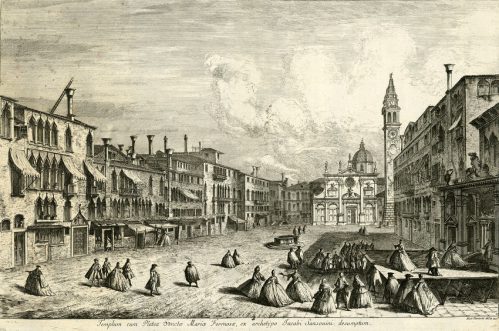By Plinio Corrêa de Oliveira
This is the square of Santa Maria Formosa in Venice. At the right is a small palace, of which only a part can be seen. In front of it is a wooden platform, probably placed there for some open-air theater presentation. The personages in the scene, who appear to have been rehearsing, are slowly going their separate ways through the empty square. The square, in whose center is a well, is flanked on both sides by residential buildings, some more distinguished, with an air of nobility, and others more simple; some have shops on the ground floor. It could be called a peaceful, harmonious little universe, to a certain extent closed to the rest of the world. In it, the various social classes coexist side by side: nobility, tradesmen and laborers revolve around the church in the background, whose campanile dominates the whole picture with dignity and maternity and enriches the ambience with its lofty spiritual note.
Ceremonious and distinguished albeit marked by a note of intimacy characteristic of small squares, this microcosm reveals the spirit of a society where men were not dissolved into anonymous multitudes. Rather, they tended to form separate, organic nuclei that escaped the anonymity, isolation and annihilation of the individual by the mass.
How picturesque and human this square is! How well-structured it appears! There the different classes all dwell together harmoniously. How typically sacral it is with the radiating center of its small church! How different it is from some of today’s immense, modern squares where men, lost in an engulfing ocean of asphalt amid a sprawling, agitated mass, can see no farther than the cyclopic skyscrapers that smother them.
Ambience, Customs & Civilization, No. 125 – May 1961










